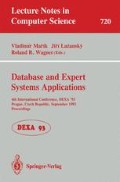Abstract
The Brain Data Base (BDB) is an innovative database that keeps (in a structural way) those anatomical and functional features of the human brain, suitable for applying the principles of biomagnetism in order to localize epileptic foci. It handles complex and non-uniform 3-D objects and admits efficient query evaluation through state-of the art computational geometry techniques. The proposed logical model of the BDB may serve as a framework for other specialized databases which deal with non-standard and involved topological information.
The experimental results that are presented in this paper have been implemented in order to derive a first prototype report, within the framework of the CEC-Program AIM, Project A2020 Magnobrain. This study conforms to the spirit of the pilot projects to be done in the U.S. Brain Mapping Initiative.
Preview
Unable to display preview. Download preview PDF.
References
Talairach J., Tournoux P., “Co-Planar stereotaxic atlas of the brain”, Georg Thieme Verlag Stuttgart, New York, Thieme medical publishers, 1988.
Anogianakis G., Krotopoulou K., Spirakis P., Terpou D., Tsakalidis A., “The logical design of the Brain Data Base”, Technical Report MB1.2, AIM-Project, Magnobrain no A2020, September 1992.
Korth E., and Silberschatz A., “Database system concepts”, McGrawhill, University of Atlas at Austin, 1986.
Rubenstein W. B.,“A Database Design for Musical Information”, Computer Science Division, University of California, Berkley, ACM SIGMOD 1987.
Mehlhorn K. and Tsakalidis A. K., “Chapter 6: Data Structures”, Handbook of Theoretical Computer Science, Editor J.V.Leeuwen, Elsevier Science Publishers, co-published by MIT — Press, pp. 301–341, 1990.
Overmars M.H. “Efficient Data Structures for Range Searching on a Grid”, Journal of Algorithms 9, pp. 254–275, 1988.
Bistiolas V., Sofotassios D., and Tsakalidis A., “Computing Rectangle Enclosures” Computational Geometry: Theory and Applications, 2, 1993.
Willard D., “New Data Structures for orthogonal range queries”, SIAM Journal on Computing, Vol. 14, pp. 232–253, 1985.
Franzblau D.S. and Kleitman D. J., “An Algorithm for Constructing Regions with Rectangles, Independence and minimum generating Sets for Collections of Intervals” in Proc. 16th ACM Symp. Theory Comput., pp.167–174, (1984).
Author information
Authors and Affiliations
Editor information
Rights and permissions
Copyright information
© 1993 Springer-Verlag Berlin Heidelberg
About this paper
Cite this paper
Anogianakis, G., Krotopoulou, A., Spirakis, P., Terpou, D., Tsakalidis, A. (1993). Brain data base (BDB). In: Mařík, V., Lažanský, J., Wagner, R.R. (eds) Database and Expert Systems Applications. DEXA 1993. Lecture Notes in Computer Science, vol 720. Springer, Berlin, Heidelberg. https://doi.org/10.1007/3-540-57234-1_32
Download citation
DOI: https://doi.org/10.1007/3-540-57234-1_32
Published:
Publisher Name: Springer, Berlin, Heidelberg
Print ISBN: 978-3-540-57234-3
Online ISBN: 978-3-540-47982-6
eBook Packages: Springer Book Archive

